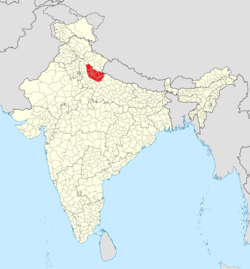This article needs additional citations for verification. (August 2020) |
Kingdom of Rohilkhand Katehir | |||||||||||
|---|---|---|---|---|---|---|---|---|---|---|---|
| 1721–1774 | |||||||||||
|
Flag of the Rohilla | |||||||||||
 Rohilkhand in India highlighted | |||||||||||
| Capital | Aonla | ||||||||||
| Common languages |
| ||||||||||
| Religion | Islam | ||||||||||
| Government | Absolute monarchy | ||||||||||
| Nawab | |||||||||||
• 1721–1748 | Ali Mohammed Khan | ||||||||||
• 1748–1754 | Abdullah Khan | ||||||||||
• 1754–1764 | Saadullah Khan | ||||||||||
• 1764–1774 | Faizullah Khan | ||||||||||
| Regent of Rohilkhand | |||||||||||
• 1748–1774 | Hafiz Rehmat Khan Barech | ||||||||||
| Legislature | Rohilla council | ||||||||||
| History | |||||||||||
• Conquests of Aonla and Barha by Ali Mohammed Khan | 1721 | ||||||||||
| 1774 | |||||||||||
| Area | |||||||||||
• Total | 12,000 sq mi (31,000 km2)[1] | ||||||||||
| Population | |||||||||||
• 1774 estimate | 6 million[1] | ||||||||||
| |||||||||||
The Kingdom of Rohilkhand was a late modern Indian kingdom under nominal Mughal suzerainty, that rose under the declining Mughal Empire in 1721 and continued to exist until 1774 when it was defeated by Oudh. The British transformed its significantly reduced borders into the princely state of Rampur. Nawab Ali Mohammed Khan became the first Nawab of Rohilkhand, having been previously elected as overlord by various Afghan chiefs at the age of fourteen. He would carve out the future kingdom from the collapsing Mughal Empire and go on to the found the Rohilla dynasty. The crown would go on being held by the Rohillas until the kingdom came to an end in 1774, and thereafter the same dynasty would rule over Rampur.

Most of Rohilkhand's borders were established by Ali Mohammed Khan and largely came into existence as a check to the power of Oudh State and in that capacity, Nawab Ali Mohammed was supported by the Wazir al Mulk, Qamarudin Khan. Nonetheless, the state grew far more influential with its borders extending to the boundaries of Delhi and Agra. In 1757, the powerful Maratha Empire defeated the Rohillas and Afghans near Delhi and Najib Khan was taken prisoner. In 1772, Rohillas defeated a much larger Maratha force with aid of Nawab of Oudh. However, when they could not repay the debt, Nawab of Oudh invaded Rohilkhand in 1773. Most of the kingdom was annexed at the end of the First Rohilla War into Oudh, when the mismanagement of Hafiz Rehmat Khan along with the internal division of the Rohilla Confederation led to the weakening of central authority.[2]
- ^ a b Strachey, Sir John (1892). Hastings and the Rohilla War. Clarendon Press, Oxford University. p. 7–10.
- ^ War, Culture and Society in Early Modern South Asia, 1740-1849
